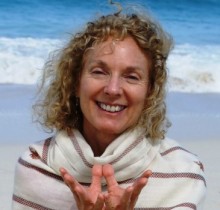 “The yoga mat is a good place to turn when talk therapy and antidepressants aren’t enough. ” I recently saw myself quoted on Facebook, a paraphrase of something I said, which is fine by me. What surprised me was the beautiful image paired with my words. It was a picture of a healthy, young, lean woman in a perfect udhva dhanurasana, the wheel pose. Attaining yoga (union, or the cessation of distractions in the mind) does not require the mastery of wheel pose or any other posture. Personally, I love practicing wheel, also known as upward facing bow pose. It’s an ancient posture, a mudra (seal), unlike many of our standing poses, which have a more recent history. Accomplishing this practice both opens the heart and brings the head below the heart, so it is both a backbend and an inversion. As such, it is a wonderfully exhilarating pose for depression. The model in the picture likely felt uplifted emotionally, physically, mentally and spiritually after the photo shoot. But yoga and its practice is so much more than a physical asana practice, requiring a yoga mat.
“The yoga mat is a good place to turn when talk therapy and antidepressants aren’t enough. ” I recently saw myself quoted on Facebook, a paraphrase of something I said, which is fine by me. What surprised me was the beautiful image paired with my words. It was a picture of a healthy, young, lean woman in a perfect udhva dhanurasana, the wheel pose. Attaining yoga (union, or the cessation of distractions in the mind) does not require the mastery of wheel pose or any other posture. Personally, I love practicing wheel, also known as upward facing bow pose. It’s an ancient posture, a mudra (seal), unlike many of our standing poses, which have a more recent history. Accomplishing this practice both opens the heart and brings the head below the heart, so it is both a backbend and an inversion. As such, it is a wonderfully exhilarating pose for depression. The model in the picture likely felt uplifted emotionally, physically, mentally and spiritually after the photo shoot. But yoga and its practice is so much more than a physical asana practice, requiring a yoga mat.
I remember 84-year-old church-going Dorothy Wheeler, who ten years ago was a regular member of my class at the Tucson Racquet and Fitness Club. I wrote about Dorothy in my first book, Yoga for Depression. Dorothy didn’t practice wheel pose nor was she able to practice with proficiency many of the other postures I led in that mixed-level class. But she let me know at the end of each session how uplifted she felt, and how blessed she felt to have yoga in her life. Old or young, fit or physically challenged, flexible or stiff, large-bodied or lean like the model in the Facebook image–anyone can practice yoga on and off the mat.
There are breathing practices, meditations, mudras, mantras, bhavana (imagery) that can balance the body-mind, no matter what level of experience or physical challenge we may have. These mat-less practices clear your inner space, reduce your distracting thoughts (yoga citta vritti nirodhah, Patanjali, 1:2) so that, even for a moment, you have a felt sense of your own true nature—eternally and intimately connected, whole and healed.
The DVD I review below by master Kripalu Yoga teacher Megha Nancy Buttenheim is a simple, gentle practice—no wheels there! But practicing with Megha is Yoga.
Blessings on sustaining your practice through the holidays. It will make all the difference in your life and the lives of your beloveds, those you serve, and all those you meet on your journey.
- Research: Compassion can be taught
- Research: Kripalu Research Grant
- Review: Yoga Therapy for Children with Autism and Special Needs by Louise Goldberg
- Review: Introduction to Yoga and Meditation with Megha
- News: O Magazine features Jacquelyn Jackson, Janice Gates and Amy Weintraub
- News: Amy’s feature article in Yoga Therapy Today
- Events: Upcoming LifeForce Yoga Practitioner Training Opportunities
- Events Calendar
Research: Compassion can be taught
The foundation of LifeForce Yoga is the cultivation of compassion and self-awareness. Much of what we teach in LifeForce Yoga, on and off the mat, is about learning to observe whatever is arising without judgment. The development of the observing, compassionate mind, helps us self-regulate and we find that we are less reactive to life’s challenges. I truly believe that developing self-acceptance and compassion is a practice, just like rolling out a yoga mat. It is therefore gratifying to read studies that validate this assumption.
A new study by researchers at the Center for Investigating Healthy Minds at the Waisman Center of the University of Wisconsin-Madison http://www.waisman.wisc.edu/ shows that adults can be trained to be more compassionate. The report, published Psychological Science, investigates whether training adults in compassion can result in greater altruistic behavior and related changes in neural systems underlying compassion.
In the study, the investigators trained young adults to engage in compassion meditation, an ancient Buddhist technique to increase caring feelings for people who are suffering. In the meditation, participants envisioned a time when someone has suffered and then practiced wishing that his or her suffering was relieved. They repeated phrases to help them focus on compassion such as, “May you be free from suffering. May you have joy and ease.”
Participants practiced with different categories of people, first starting with a loved one, someone whom they easily felt compassion for, like a friend or family member. Then, they practiced compassion for themselves and, then, a stranger. Finally, they practiced compassion for someone they actively had conflict with called the “difficult person,” such as a troublesome coworker or roommate.
The study’s lead author, Helen Weng, says, “It’s kind of like weight training. Using this systematic approach, we found that people can actually build up their compassion ‘muscle’ and respond to others’ suffering with care and a desire to help.”
Compassion training was compared to a control group that learned cognitive reappraisal, a technique where people learn to reframe their thoughts to feel less negative. Both groups listened to guided audio instructions over the Internet for 30 minutes per day for two weeks. “We wanted to investigate whether people could begin to change their emotional habits in a relatively short period of time,” says Weng.
The real test of whether compassion could be trained was to see if people would be willing to be more altruistic — even helping people they had never met. The research tested this by asking the participants to play a game in which they were given the opportunity to spend their own money to respond to someone in need (called the “Redistribution Game”). They played the game over the Internet with two anonymous players, the “Dictator” and the “Victim.” They watched as the Dictator shared an unfair amount of money (only $1 out of $10) with the Victim. They then decided how much of their own money to spend (out of $5) in order to equalize the unfair split and redistribute funds from the Dictator to the Victim.
“We found that people trained in compassion were more likely to spend their own money altruistically to help someone who was treated unfairly than those who were trained in cognitive reappraisal,” Weng says.
The researchers also used fMRI to look at brain changes in the two groups and found that the people who were the most altruistic after compassion training were the ones who showed the most brain changes when viewing human suffering. They found that activity was increased in the inferior parietal cortex, a region involved in empathy and understanding others. Compassion training also increased activity in the dorsolateral prefrontal cortex and the extent to which it communicated with the nucleus accumbens, brain regions involved in emotion regulation and positive emotions. This may be an indication of mood elevation.
I find that when we are guided to feel compassion for others and to ourselves (Karuna meditation) or to send loving-kindness (Metta meditation) to ourselves as well as others, even or perhaps especially to those with whom we have challenges, we end up feeling happier and more at peace.
The article was published by Psychological Science. To read the full article please click here.
Research: Kripalu Research Grant
The Kripalu Center for Yoga and Health announces: The Samuel B. Hanser Visionary Award for Yoga Research. Letters of Intent due by February 15, 2014
Kripalu’s Institute for Extraordinary Living is thrilled to announce the establishment of the Samuel B. Hanser Visionary Award to advance innovations in yoga research. This is the first grant targeted specifically to support yoga research, furthering the goal of making yoga more accessible and accepted throughout society as a means for creating health and well-being.
The award honors the spirit and vision of the late Samuel B. Hanser, a healer who believed that every person holds the wisdom and power to lead a happy and healthy life. After Sam’s death at the age of 28, his family created a Memorial Trust in his name, and have now established the Hanser Award in collaboration with the Institute for Extraordinary Living (IEL).
The Hanser Award will be given to a dedicated and creative professional whose work directly contributes to Kripalu’s mission to empower people and communities to realize their full potential through the transformative wisdom and practice of yoga.
Letters of intent are due by February 15, 2014, with detailed proposals to be submitted later in the process. An inaugural award of up to $10,000 will be presented in September.
For application details and further information, please click here.
Email: research@kripalu.org
Review: Yoga Therapy for Children with Autism and Special Needs by Louise Goldberg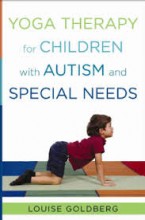
Reviewed by Ellen Campbell. Ellen Campbell teaches yoga to children and adults in Tucson, Arizona. She is a LifeForceYoga Level I practitioner and author of the Youthful Yogis Blog.
It is often easy in our fast paced, media rich culture to associate yoga with bustling studios, fashionable sportswear, and fit and flexible bodies such as we see on the covers of most health and yoga magazines. However, in her new book, Yoga Therapy for Children with Autism and Special Needs, Louise Goldberg reminds us that yoga is so much more than a glossy cover story or a speedy set of sun salutes.
Yoga Therapy for Children with Autism and Special Needs offers readers what Goldberg calls “a curriculum for calm”: a road map, if you will, for the successful integration of yoga into the lives of children with special needs. The author draws upon her 30 years of yoga therapy experience to create a rich and nuanced work that will inspire teachers, therapists and parents alike. It is a book that can be appreciated by experienced practitioners as well as by individuals who are just beginning to explore the benefits of yoga therapy for children.
Yoga Therapy for Children with Autism and Special Needs makes a point of distinguishing the difference between yoga classes and yoga therapy, noting the highly individualized nature of yoga therapy and the idea that in yoga therapy “the child’s responsiveness is the measure of success, rather than achievement of a specific pose.” Ms. Goldberg is honest about the joys, as well as the challenges, of working with children with special needs (Down Syndrome, Autism Spectrum Disorder and ADHD, to name a few.) Her “Ten Golden Rules of Teaching” offer tools for success when working with children and include: “See the whole child”; “Make yoga therapy fun”; and “Take nothing personally!” The author also underscores the importance of “creating a sacred space” for children with special needs. She prefaces this theme with a chapter entitled Stress and the Brain, a segment of the book that I will personally be referring back to time and again.
In her chapter on stress and the brain, as well as in the subsequent chapter on relaxation, Goldberg offers an overview of the body’s response to the environment via the nervous system. She reminds us that school settings–often noisy and highly stimulating environments–can easily trigger the fight or flight response in children, especially those with sensory challenges or an inability to self-sooth. Here is where “creating a sacred space” becomes so important; Goldberg underscores that yoga therapists must attune to a child’s environment–adjusting the temperature and the lighting, choosing music (or not) and even becoming aware of the tone of their own voice and the expression on their face–in order to support feelings of safety and security in the child. The author notes that periods of transition, as well as changes in routine, can be particularly stressful for children with special needs. She suggests visual aides, transitional cues and the creation of a set routine in order to reduce anxiety in children who may be distracted or overwhelmed by sensory stimulation. Finally, Ms. Goldberg gives concrete examples of ways all individuals can remove undue stress from the body’s systems. Postural adjustments, breath work, ocular pressure and—for some—gentle inversions and/or flexion of the cervical spine are just a few of the techniques Ms. Goldberg suggests to “stimulate vagal motor neurons, slowing the heart” thus supporting the body to relax.
While there is much to appreciate about Yoga Therapy for Children with Autism and Special Needs, it is in chapter fifteen that parents, teachers and therapists truly receive a great gift: Louise Goldberg lays out a “Catalog of Postures”, offering descriptions of approximately sixty positions that can be adjusted to the needs of any child or group of children. The list begins with simple therapeutic hand positions, moves onto breath work, seated poses, twists, partner poses and standing postures for strength and balance. The benefits of each posture are listed, and contraindications and adaptations for special needs are provided. Goldberg also offers nine different posture routines of varying intensity and then gives us routines specifically designed for a school setting: a posture routine for small spaces, a routine for after lunch, and a routine for test anxiety, just to name a few.
Finally, readers are provided with a list of postures and lessons for specific needs including: eye-hand coordination, vagal nerve stimulation, language development and poses for enhancing social interaction. Yoga Therapy for Children with Autism and Special Needs concludes with games, songs, mudras and partner poses for children to enjoy. The appendix offers readers useful yoga therapy resources including a parent questionnaire, a teacher assessment form, a student questionnaire and an extensive list of training resources.
Reading through Louise Goldberg’s Yoga Therapy for Children with Autism and Special Needs, one does indeed feel as though they are receiving a gift: it is the gift of information and insight–precious knowledge that can expand and evolve as educators move forward in their work with children.
I highly recommend this book and I thank Louise Goldberg for sharing her expertise and experience with us. A “curriculum for calm” is something that we can all benefit from, and Ms. Goldberg helps us to make this curriculum a reality.
To purchase a copy of Yoga Therapy for Children with Autism and Special Needs please click here.
Review: Introduction to Yoga and Meditation with Megha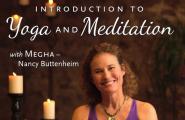
Megha Nancy Buttenheim and I found our way to Kripalu Yoga, the practice that in the late 80’s saved my life and enabled me to slowly, with medical supervision, titrate off anti-depressant medication. Megha was already teaching at Kripalu when I arrived and was a teacher whose joy and compassion inspired my own practice. Many of you may know her as the founder of Let Your Yoga Dance, and have experienced her exuberant yoga dance at noon classes at Kripalu Center for more than twenty years.
This is her first DVD, and it is one I can imagine growing old with. It is bar-none the best beginner gentle yoga DVD practice I have ever experienced, because not only is there a practice where modifications are shown throughout, but there are teaching segments that educate the participant, providing a strong and confident foundation to the novice, before she or he begins the actual practice session. Megha is thorough and clear in her explanation and demonstration of the use of props. She carefully describes and demonstrates how to support the participant in maintaining a seated position for meditation. She slowly demonstrates two of the most basic and , to my mind, life-changing breathing practices. Participants are guided through a thorough understanding of the seven movements of the spine, essential to hydrating and keeping the spine flexible. There are two teaching meditations—a mindful attention to the breath and the Buddhist practice of Metta (loving-kindness).
The 60 minute Sequence of poses that follows the teaching segments includes a centering meditation, warm-ups, standing poses, a gentle backbend in a prone position, gentle twists and an inversion, all practiced and demonstrated with options for modifications and props. The posture section is followed by a guided relaxation that includes polarity breathing, a practice that draws breath in and exhales the breath out through opposite parts of the body. Megha leads a brief seated meditation to close the practice that includes both breath awareness and Metta practice.
As a yoga teacher for 23 years, I know that it is often more challenging to teach a beginning yoga class, especially for people who may have physical challenges that make modifications necessary. It is an art to make everyone, no matter what their limitations, feel welcomed and accepted just as they are. Megha’s great gift as a teacher is to offer a true experience of yoga-union to the participants in the class, regardless of their level of experience or need to modify.
Although shot simply in a beautiful studio space, production values are high on this Trudy Manion Production. Yoga teachers will benefit from studying this DVD, so that they can offer not only the modifications, but the compassion and wisdom that Megha provides. And of course, if you need to adapt and modify to meet your own body’s needs, then this is the practice for you. Did you notice that throughout this review, I used the word “participant” rather than “viewer”? That’s because, although my own level of practice is more vigorous, not for a moment did I feel I was not practicing yoga, as Megha guided me with clarity and compassion through this DVD. I felt that she was right there in the room with me and felt her big heart smiling.
To purchase a copy of Introduction to Yoga and Meditation with Megha please visit: Letyouryogadance.com.
News: O Magazine features Jacquelyn Jackson, Janice Gates and Amy Weintraub
The December 2013 Issue of O Magazine features an article “The Yoga Prescription: The ancient practice goes from gym class to doctor’s orders” about Jacquelyn Jackson and her battle with depression after witnessing the shooting of her boss congresswoman Gabrielle Giffords in 2011. A large part of her treatment included LifeForce Yoga sessions with Founder Amy Weintraub.
For Jackson, one-on-one yoga appointments with Amy Weintraub, a pioneer in the field and author of Yoga for Depression, proved transformative. In their first session, Jackson “was practically hyperventilating with anxiety;’ says Weintraub, who created a program that included “stairstep” breathing, building up to deeper and deeper breaths. “What the yoga did was provide a slow, gradual path to help her manage her moods and not immediately react when grief arose.” After just a few sessions, Jackson no longer used medication to help her sleep at night. “Working with Amy was like doing emotional Rota-Rootering;’ she says. “I had so much stress in my body, and she was able to help dislodge it and clear it out.”
To read the full article please click here.
News: Amy’s feature article in Yoga Therapy Today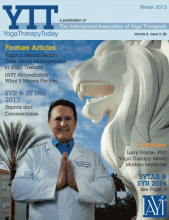
“The Two-Way Street: Integrating Yoga into Mental Healthcare and Mood Management into Yoga Therapy”. Amy has written an article on what has become a subject of debate in the yoga therapy community—how much training in yoga mental health professionals need to offer clinically appropriate yoga practices like pranayama breathing and meditation in psychotherapeutic treatment and how much training in mental health yoga professionals (teachers, therapists) need to offer yoga practices to special populations suffering from mood disorders, trauma and addictions. In this article she outlines a teachable set of skills for yoga therapists and psychotherapists who work with people with mood imbalances that specialty training programs for mental health and yoga professionals can provide.
To read the article, click here.
Article Source: Yoga Therapy Today
Publisher: International Association of Yoga Therapists
Events: Upcoming LifeForce Yoga Practitioner Training Opportunities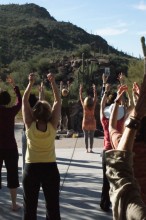
Tucson, AZ – Level 1 Residential, January 12 – 19th, 2014. Click here for more information.
Paradise, Island, Sivananda Ashram Residential Module A February 6 – 10th, 2014. Click here for more information.
About the Modular Level 1 LFYP Training
Train to become a LifeForce Yoga Practitioner with Amy Weintraub and a faculty of Yoga and Mental Health Professionals. Learn an evidence-based yoga protocol appropriate in yoga classes, yoga therapeutic and health care settings. CEUs.
Events Calendar
View our latest schedule of Workshops and Trainings!